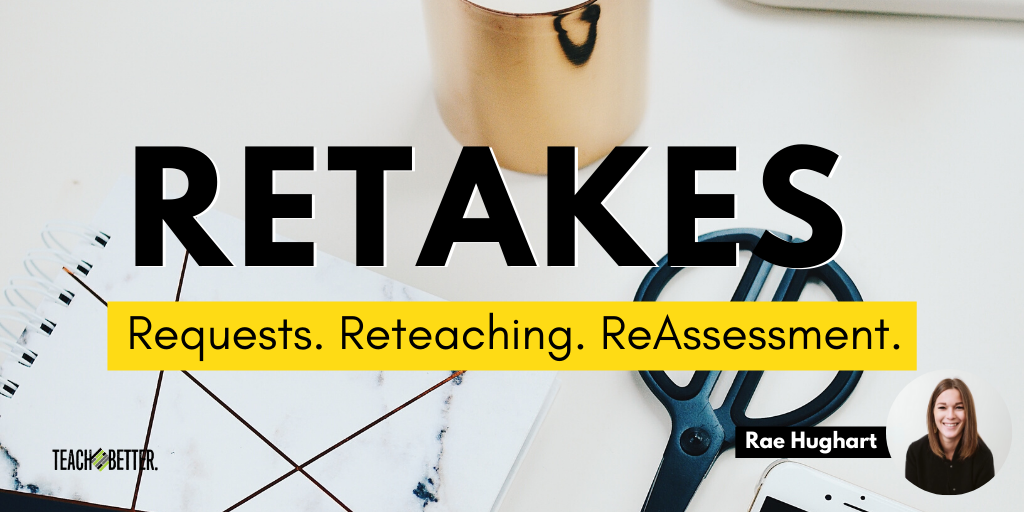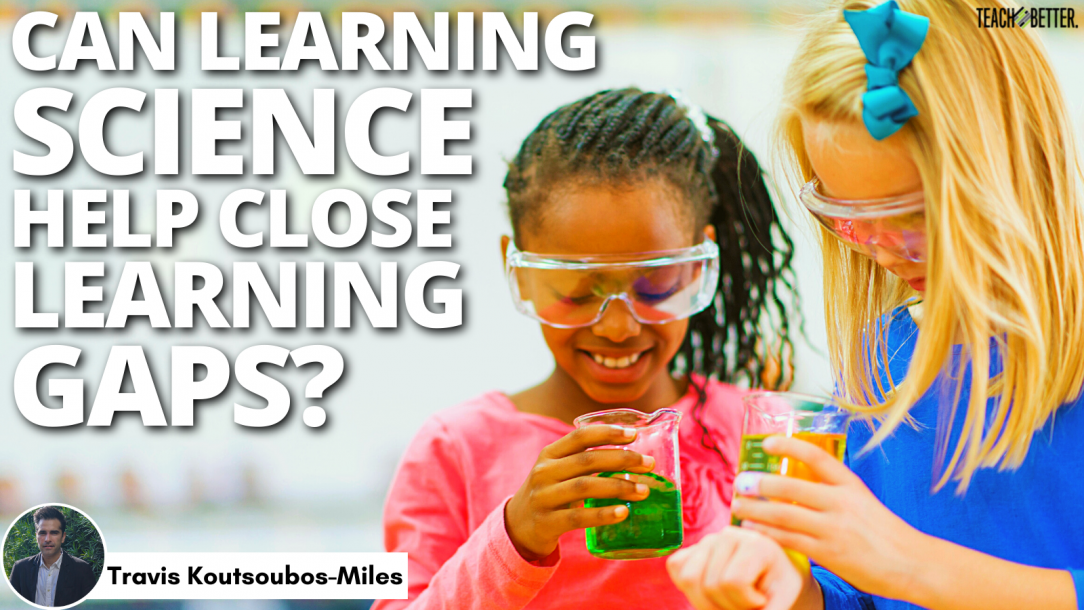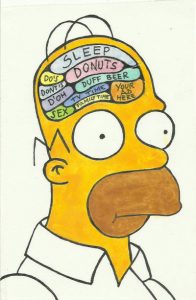TL;DR:
- Learning new skills or content is hard, and COVID has made it even harder. But learning science can help.
- When learning something new, information enters our working memory system, but often isn’t stored in long-term memory.
- Passive learning strategies (like re-rereading material) do not help us retain information, but retrieval practice does.
- Retrieval practice involves the recollection or resurfacing of facts, ideas, or skills we have previously acquired to varying degrees.
- Retrieval practice forces us to draw out information that has previously been internalized.
- The act of retrieving this information helps organize and consolidate it for future use.
- Brain breaks and sleep also promote retention.
- Working memory capacity varies among students, but teachers can lighten the cognitive load students bear by implementing specific learning strategies.
Can Learning Science Help Close Learning Gaps?
Homer Simpson’s weight loss journey takes an unexpected turn when he unknowingly receives the wrong self-help cassette. He doesn’t receive the appetite control tape he ordered. Instead, a vocabulary enhancer comes in the mail.
Eager to lose weight, Homer puts the cassette on just before knocking off for bed (i.e. the tape purportedly works through osmosis).
But when Marge asks whether he is less hungry the following morning at the breakfast table, Homer discovers his appetite hasn’t changed. But his powers of language have. “Lamentably no,” he says, scarfing down handfuls of bacon and stacks of pancakes. “My gastronomic rapacity knows no satiety.” Homer gains weight and throws the tape away in frustration. Soon after, his language abilities return to normal. “Marge…where’s that…metal dealie…you use to dig food,” he asks, as he holds an ice-cream container. “You mean a spoon,” she replies? “Yeahhhhhhhh,” Homer exclaims.
The Universal Struggle to Learn
Jesse Singal relates this humorous vignette to Western culture’s obsession with quick fixes. But it speaks to something even more timeless — our universal human struggle to learn. It cartoonishly pictures how we acquire information. But the vignette also depicts how quickly we forget information, a vanishing act that frustrates all learners regardless of whether they’re learning in a classroom or online during a pandemic. Fortunately, a sub-discipline called “learning science” is here to help.
Now’s an Ideal Time to Glean From Learning Science
Learning science can be defined as the field where cognitive psychology, neuroscience, and education intersect . It aims to understand the challenges learners face in order to stem the tide of forgetting. Now is an ideal time to leverage its insights. Pandemic news coverage has triggered parental and educator anxiety over how will we recover the learning lost due to missed instruction.
In place of this hand-wringing, a newly published book, Uncommon Sense Teaching: Practical Insights in Brain Science to Help Students Learn, shows us how to optimize learning spaces and activities for students.
As a former teacher, I heartily recommend it to all educators and administrators. Hopefully, this synopsis underscores some of Uncommon Sense Teaching’s most intriguing ideas, increasing interest in the topic of educational neuroscience and the book itself so that students don’t lose their learning gains as quickly as Homer did.
In addition to improving our scientific literacy and self-understanding as learners, Uncommon Sense Teaching is full of fresh, practical ways to apply its insights to the classroom. - Travis Click To TweetUnderstanding Common Learner-Delusions
Students and teachers regularly fool themselves into thinking they’ve mastered information — long before they indeed have.
Ineffective study methods only enhance these delusions. Highlighting textbook material or class notes (or listening to pre-recorded lectures over again) convince learners they’ve deeply comprehended something. But shut the textbook, hit pause on the lecture, and students no longer “get” what they understood seconds before. Students repeat this common learner’s delusion when they “cram” for a test — and do well on it — but “bomb the final” months later. Where does the information go? Why is learning so hard?!? D’oh!!
Some of the Physical Mechanisms Behind Forgetting & Retention
There’s a physical explanation for these sudden disappearances — information has not been stored as long-term memories in the neocortex, a process called consolidation. Uncommon Sense Teaching provides a helpful snapshot of the processes and brain regions involved in this critical phase of the learning cycle (See Uncommon Sense Teaching, Chapter 1).
When consciously learning new facts or ideas (e.g. someone’s phone number), we activate our working memory system. This system is responsible for temporarily storing information. And what we don’t immediately forget is stored in the hippocampus and neocortex.
At first, this information exists as brain clutter in the neocortex. But with continual reactivation, the hippocampus “helps” the neocortex organize this new data into retrievable information — the way a friend helps unload boxes and organize their contents after the moving truck comes. Once these neocortical links stabilize (i.e. a physical process of change that happens inside and between neurons), new memories are consolidated, becoming, to varying degrees, hippocampal-independent (which can take days to months).
Without this reactivation, unused neural links die — the brain has no purpose storing information it doesn’t use.
So what learning strategies discourage forgetting in the use-it-or-lose-it-brain? Which ones help us consolidate short-term memories into long-term ones?
What Is Retrieval Practice and How Is It Done?
In place of passive learning methods—like re-reading material—Uncommon Sense Teaching recommends active learning strategies like retrieval practice (See Chapter 3). Extensive controlled experimental research over the past thirty years, conducted in both laboratory and classroom settings, reveals the remarkable success of retrieval practice at improving retention and skill-mastery. Retrieval practice resurfaces facts, ideas, and skills from memory as subjects test themselves and are tested, irrespective of the learning experience. Whether one is trying to improve one’s tennis serve, sharpen one’s math skills, or learn a foreign language, retrieval practice reactivates and reorganizes data and information the learner has latently processed.
As it relates to studying at home, retrieval practice involves students quizzing themselves with flash-cards, answering chapter summary questions, and taking practice exams.
In the classroom, educators can encourage students to take notes after the presenter has finished speaking (a method dubbed retrieve-taking), which spurs active listening and recall. Peer-teaching, review games, and test-taking do the same. Lastly, teachers can maximize the benefits of retrieval practice by spiraling content, weaving key content from each unit into reviews, homework, and assessments throughout the semester/year.
In distinction from passive strategies, like simply re-reading material, retrieval exercises reactivate previously stored information. And this activity signals the brain should dedicate more brain food (called neurotrophins) to strengthen and refine active neural circuits. Just as the squeaky wheel gets the grease, active neural networks receive neurotrophins. As these networks collect nutrients, they expand and undergo refinement. And as their neural circuitry consolidates, they reorganize and store information for future use.
So Practice, Practice, Practice?
Retrieval practice confirms the time-honored wisdom that “practice makes perfect.” So it’s fair to wonder what value learning science contributes. Don’t we already know students require practice to improve?
Surely most teachers and students believe this—at least, to some degree. But a science-informed understanding of retrieval practice fortifies this conviction. Learning science doesn’t simply dogmatically tell us to practice: it explains how practice shapes our nervous system. And students and teachers alike enjoy knowing why we should do something before committing to it.
It’s fair to ask why, in theory, repetition is necessary? Couldn’t the brain encode information through one-trial learning the way a seal stamp shapes hot wax? Perhaps memory doesn’t generally work this way because encoding every single experience would waste precious computational space. Be that as it may, our concern is understanding how to make learning stick. And cognitive neuroscience provides clear instructions. For consolidation to take place, information has to be tagged as relevant and extensively practiced.
Rest Also Promotes Retention
Somewhat paradoxically, rest is also critical to promoting consolidation. To that end, Uncommon Sense Teaching recommends providing students with brief “mental interludes.”
To anthropomorphize the brain again, the hippocampus is a diligent worker . But it cannot receive information from working memory and, simultaneously, “help” the cortex consolidate information. A solution, our authors write, are “brain breaks.” Even thirty-forty second long rest periods , taken in between key points or lesson segments, can help students store information into long-term memory.
And sleep plays an even greater role stabilizing new memories. Subliminal learning cassettes like Homer’s vocabulary enhancer are, of course, the stuff of science fiction. And teachers don’t have magic wands to keep students from staying up all night playing video games and watching Netflix. But adequate sleep encourages memory consolidation. Teachers can limit the amount of homework students receive. By sharing a digital test/essay calendar, grade-level teachers can monitor whether the recommended nightly homework amount is exceeded and make appropriate adjustments.
[scroll down to keep reading]
Practical Insights About Inclusion and Differentiation
The concepts “retrieval practice” and “rest” promote classroom learning and retention for all learners. But Uncommon Sense Teaching also helps us make class more inclusive for students with special education needs and requirements.
Much of the book’s attention on inclusivity revolves around the concept of “working memory capacity,” which varies considerably among learners.
Some students initially store and process greater amounts of information than others. Such students are like “race cars.” Though advantageous in ways, zipping through learning material has its downsides too. Swift-learning can lead to missing critical insights and appreciate connections between ideas. In contrast, “hikers,” with less working memory capacity, often make discoveries their fast-moving peers gloss over because they’re in less of a rush to finish the book or lesson. In fact, the father of modern neuroscience, Santiago Ramón y Cajal, attributed his discovery of the neuron doctrine to his “slower, more flexible, way of thinking” (see Chapter 2).
So how can classroom educators help “hikers” reach their academic potential?
In addition to retrieval practice and brain breaks, the authors recommend several other strategies, which seasoned educators will recognize. For myself, these strategies, such as chunking information, visually displaying key content, and employing word economy gain renewed importance when the cognitive overload problem is born in mind.
Online teaching can also play a pivotal role towards helping hikers progress (See Chapter 9). Posting instruction videos online provides students with the chance to gain repeated exposure to information. But it also allows “race cars” to move through material at their own pace as well. Online teaching, thus, not only enhances inclusivity, it also creates differentiated learning opportunities for students.
So Purchase The Book – or Get Your Admin To!
In addition to improving our scientific literacy and self-understanding as learners, Uncommon Sense Teaching is full of fresh, practical ways to apply its insights to the classroom. Most importantly, the book reveals that learning hinges less on teacher actions and more on whether students are given sufficient time and space to actively process what we’ve taught them.
Informed by learning science, our best teaching can encourage students’ attention, retrieval, rest, and consolidation. Written by scholars but for lay people, Uncommon Sense Teaching firmly places parents and educators well on our way to helping students do so.
About Travis Koutsoubos-Miles
Travis Koutsoubos-Miles studied philosophy and theology at Wheaton College. After earning his degrees, he taught history at a private high school and then English composition at KIPP Houston High School, where his students soared scholastically. He is now Executive Director of an education startup called Born to Know, which provides curricular resources to students and educators. His writing on the topic of academic growth in the area of English language achievement has been published and commented on.





